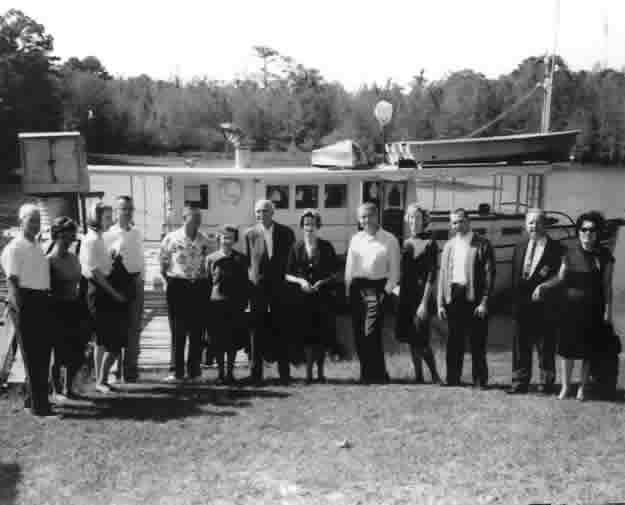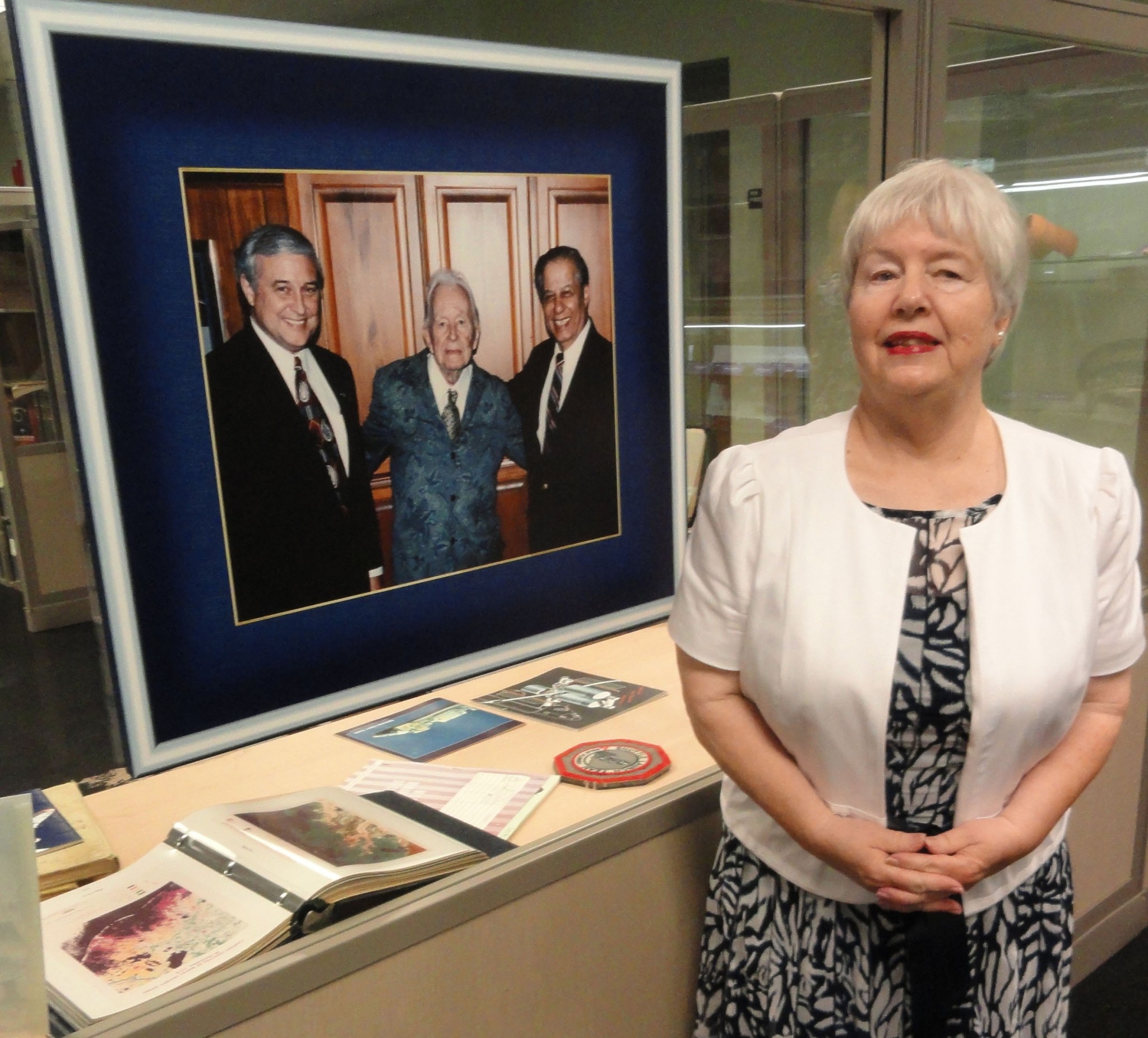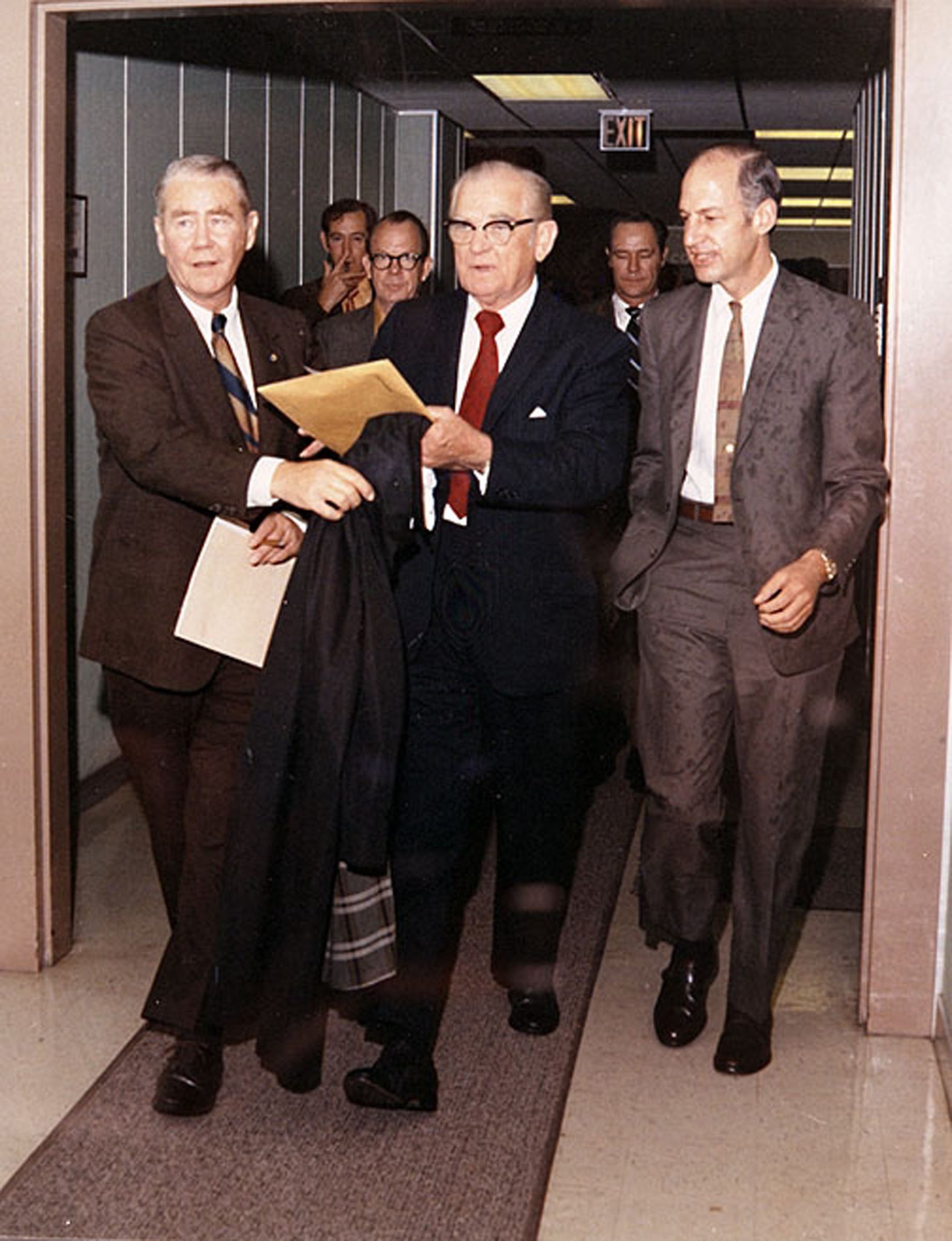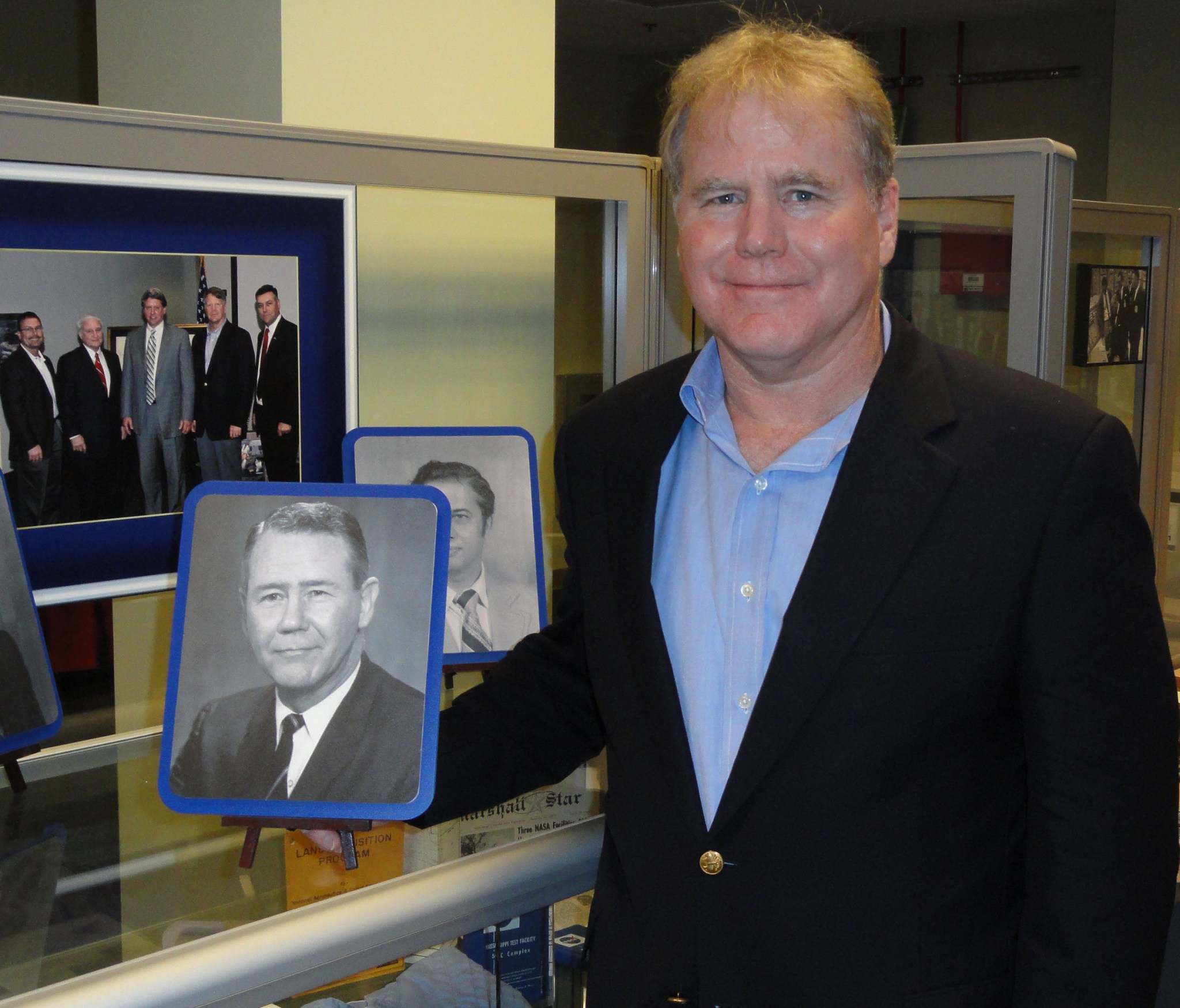The children of Leo Seal Sr., Capt. William C. Fortune and Jackson Balch Sr. all share a common bond: Their fathers played vital roles in grassroots efforts during the formative years of the John C. Stennis Space Center in Hancock County, Mississippi.
During oral history interviews conducted by Stennis’ History Office, Virginia Seal Wagner, Wealtha Fortune Weaver and Jackson “Jack” Balch Jr. reflected on memories of their fathers in conjunction with the center’s 50 years of existence.
In August 1961, NASA made a decision to locate a “National Test Site” to test large launch vehicle rocket stages on the Pearl River in Hancock County. The announcement to build the new facility came shortly after President John F. Kennedy proposed on May 25, 1961, that the United States commit itself to the goal of landing humans on the moon and returning them safely to Earth before the end of the decade.

“I don’t know yet what method we will use to get to the moon, but I do know that we will have to go through Mississippi to get there,” said the late German scientist Dr. Wernher von Braun, former director of the George C. Marshall Space Flight Center in Huntsville, Ala.
Hancock County was selected as NASA’s engine test site for its isolation from populated communities; accessibility by water and highway; availability of utilities; supporting communities within 50 miles; and climate permitting year-round operation. With verbal approval by then-NASA Administrator James Webb, the Pearl River site was announced to the public Oct. 25, 1961, by NASA and U.S. Sen. John C. Stennis of Mississippi.
A week later, Stennis informed 1,500 Logtown residents of NASA’s plans to buy their property to build a rocket engine test facility, along with land in the surrounding towns of Gainesville, Santa Rosa, Napoleon and Westonia. He said the federal government was ready, able and willing to pay full compensation for the property involved. Stennis estimated the land acquisition and easements would cost about $13.5 million.
“Sen. Stennis contacted my father (Leo Seal Sr.) and asked would he come to Logtown with him to tell these people that ‘we were going to take their land away,’” said the late 81-year-old Virginia Seal Wagner, who passed away about a month after this interview. “My dad and mother (Rebecca Baxter Seal) were born and raised in Logtown. So, he had some connections there, and Sen. Stennis thought that would be a friendly face.”

“I remembered when that happened. There were a lot of unhappy people. They were on a flat bed truck the first time they spoke. Then, I remember going to the first big meeting at one of the school auditoriums when everybody could come and voice an opinion.”
Wagner said her father supported the cause and was a well-respected banker at the community’s Hancock Bank.
Named the Mississippi Test Operations (MTO) in 1961, the U.S. Army Corps of Engineers began land acquisition negotiations in 1962. By 1963, 660 families had given up their homes prior to construction. NASA had acquired a 13,800-acre “fee” area for its facilities that were surrounded by a 125,000-acre noise buffer zone designated a national asset.
On Oct. 1, 1962, Navy Capt. William C. Fortune was appointed the first manager of MTO, a division of Marshall Space Flight Center (MSFC). Fortune was personally selected by von Braun to build the Mississippi test site for the Apollo moon rocket stages. With an extensive military and rocketry background, Fortune met and became friends with von Braun in 1947 when they both worked on a project that launched the first large rocket from a U.S. Navy ship.
“Fifty years ago, my father was one of the pioneers who planted the seed of vision for NASA’s space rockets test facility, along with Wernher von Braun and the other involved scientists and dynamic individuals who were carefully picked,” said Ocean Springs resident Wealtha Fortune Weaver, the second of Fortune’s three daughters. “Wernher von Braun and his fellow scientists had a vision for the space program. Part of this vision was to have the right team of pioneers.”

“Dad was put on loan to NASA from the U.S. Navy. The military was very respected, and NASA utilized this relationship.”
Fortune reported to headquarters in Huntsville the first year to work with Von Braun and other NASA associates to finalize plans for MTO. A month later, and before construction started, a sign of the space age was evident in Mississippi when the first flag-raising ceremony took place on Nov. 21, 1962. It was staged in the front yard of the site’s Rouchon House, where NASA officials established their headquarters in the old town of Gainesville.
“They worked in almost primitive conditions at the test site, which was a wilderness in the beginning. Dad would bring my sister and me out onto the grounds on the weekends when we were home from college so we could see what was planned and what was going on,” said Weaver, of she and her sister, Laurie. “Getting chased by wild wart hogs was a really new and different experience! We had never seen the likes of Spanish moss or so many bugs or shrimp out of the cocktail bowl having so many legs and feelers!”
Fortune and wife Elizabeth “Libby” and their children, who resided in Pass Christian, were said to have captured the hearts of the people of the Gulf Coast as NASA’s “first family.” They became well-known as the space program’s best ambassadors to Mississippi.
Wagner’s brother, the late Leo Seal Jr., who was a staunch Stennis Space Center supporter, once said Capt. Fortune was the personification of “an officer and a gentleman.”
“A group of adventurous pioneer scientists were living out their dreams that have continued to the culmination of the Stennis center as it is today. These men were real, live, dashing heroes of strong character and direction. Their brilliant contributions to science came to fruition,” said Weaver. “Dad would be so proud to see that the original ‘vision’ of NASA’s plan for man’s exploration of space and the space programs’ contributions to new technology continues to flourish and grow at this great site.”

Another elite von Braun protege, Jackson Balch Sr., was named the second manager of the facility in 1965. He transferred from MSFC, with dual assignments as site manager and head of the then-Mississippi Test Facility Task Force to complete construction and activation of the test site. He was known throughout NASA as a “maverick” with his daring management techniques.
Balch’s 10-year tenure at MTF was just as eventful as the day he moved his family into their home in Pass Christian. “The first day we moved into the house, Hurricane Betsy hit the Gulf Coast in 1965,” said Balch, the fifth of six children. “It was an interesting welcome. It was rather a provoking introduction to life in the hurricane zone.”
During Jackson Balch’s career, the first-ever rocket engine test took place at the facility in 1966. By 1967, Balch was concerned about MTF’s future and initiated a meeting with Sen. Stennis and von Braun. A few weeks after the first man landed on the moon in 1969, he worked with community recovery efforts from Hurricane Camille, along with issues related to a declining workforce.
Balch was known as the architect of Stennis’ multiagency concept. He was largely responsible for the transformation of the facility from a single mission of rocket engine testing into a continuous operation that the community could benefit from in the future.
“It was a pressure-packed time,” said Balch of his dad’s work to save the facility from closure. “It was a real struggle for him. I particularly remember him coming home, and he would sit in a lounge chair and doze off from exhaustion. He would almost mumble words in his sleep. I knew it was stress. I could see it on his face, and I could hear it in those rumblings. This went on a couple of years. In the middle of the night, he would call people he worked with, and they would strategize. They would argue about ‘what can we do to continue the operations?’ That is where the dream of a multiagency facility began to emerge. He was in there with a lot of other people who contributed to the dream and the reality.”
What Balch envisioned more than two scores ago remains evident today. Stennis Space Center is home to more than a dozen federal agencies that are joined with 30 or more state, academic and private organizations, as well as several technology-based companies to comprise the unique federal city. It has an economic impact that provides a quality of life to 5,400 employees that extends beyond a 50-mile radius, into neighboring states Alabama and Louisiana.
The federal city approach allows resident agencies to share the cost of owning and operating the south Mississippi facility, making it more cost-effective for each entity to accomplish its independent mission, Jackson Balch’s original concept.
“He would be pretty amazed that it is still here. He would be very happy that there is this technology transfer and the sharing of laboratories and rocket testing and the sciences and engineering that our country and world have benefited as a result of having that kind of technology transfer,” Balch said.
“He would feel that was a real accomplishment and a real gold star for the community that it is here, and it not necessarily replicated that way elsewhere. He would find it to be pretty extraordinary that it has endured and very curious as to how it really evolved since then.”
Profiles of NASA Managers
Wernher von Braun
Born in Wirsitz, Germany (East Prussia), on March 23, 1912; earned a B.S. in mechanical aeronautical engineering in 1932 at Berlin Institute of Technology and a Ph.D. in physics in 1934 at the University of Berlin; became a U.S. citizen on April 14, 1955; director, NASA’s George C. Marshall Space Flight Center, 1960-1970; deputy associate administrator, NASA Headquarters, 1970-72; led efforts that put the first U.S. satellite into orbit in 1958, the first man in space in 1961 and the first man on the moon in 1969; died June 16, 1977, in Alexandria, Va., at age 65.
William C. Fortune
Born March 1, 1911, in Salamanca, N.Y., on a Senaca Indian reservation; earned bachelor’s and master’s degrees in electrical and aeronautical engineering from the Naval Academy and the Massachusetts Institute of Technology; responsible for launching the first large missile ever from the deck of the USS Midway in 1947; site manager of the Mississippi Test Operations, 1962-1965; had a 31-year career in the Navy as pilot, researcher and pioneer in rocketry; retired from NASA in 1972 as West Coast director of new technology in California; died Aug. 19, 2001, in Victorville, Calif., at age 90.
Jackson Balch Sr.
Born March 10, 1916, in Yarmouth Nova Scotia, Canada; high school graduate of the American School in Monterrey, Mexico, earned a bachelor’s degree in engineering from Trinity College in Dublin, Ireland, and master’s degree in economics from the University of North Carolina and completed extensive graduate work in industrial engineering at the Massachusetts Institute of Technology; aide to General Douglas MacArthur during World War II; second site manager of Mississippi Test Operations, 1965–1975; died Aug. 25, 1980, in Gulfport, at age 64.
For information about Stennis Space Center, visit: https://www.nasa.gov/centers/stennis/.
Rebecca Strecker
NASA Public Affairs Office
Stennis Space Center, MS 39529-6000
(228) 688-3249
Rebecca.A.Strecker@nasa.gov

























